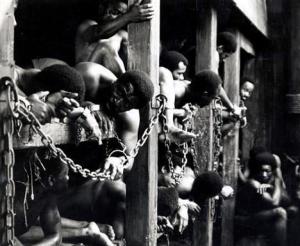Imagine if you can, being captured, put on a force march, beaten, put into pins while shackled, and then placed in a tomb like environment with people you cannot, in many cases, communicate with for months.
These were the conditions leading to that horrible journey into the unknown for millions of African’s forcibly interned into the belly of the beast with a destination unknown. His-Story speaks to this wretched practice as part of the Atlantic slave trade. However, this was more commonly known as the "Middle Passage", which refers to that middle leg of the transatlantic trade triangle in which millions of Africans were imprisoned, enslaved, and removed forcibly from their homelands never to return.
The transatlantic trade triangle worked this way. Ships departed Europe for African markets with commercial goods, which were in turn traded for kidnapped Africans who were transported across the Atlantic as slaves. The enslaved Africans were then sold or traded as commodities for raw materials, which would be transported back to Europe to complete the "triangular trade". A single voyage on the Middle Passage was a large financial undertaking that was generally organized by companies or groups of investors rather than individuals.
African kings, warlords and private kidnappers sold captives to Europeans who operated from several coastal forts. The captives were usually force-marched to these ports along the western coast of Africa, where they were held for sale to the European or American slave traders. Typical slave ships contained several hundred slaves with about thirty crew members. The male captives were chained together in pairs to save space with their right leg chained to the next man's left leg, while the women and children may have had somewhat more room. The captives were fed beans, corn, yams, rice, and palm oil. Slaves were fed one meal a day with water, but if food was scarce, slaveholders would get priority over the slaves.
The duration of the transatlantic voyage varied widely, from one to six months depending on weather conditions. Although, the journey became more efficient over time as the average transatlantic journey of the early 16th century lasted several months, by the 19th century the crossing often required fewer than six weeks. West Central Africa and Southeastern Africa was the most common region for traders to secure the human cargo that was destined for the Caribbean and the Americas.
An estimated 15% of the Africans died at sea, with mortality rates considerably higher in Africa itself in the process of capturing and transporting indigenous peoples to the ships. The total number of African deaths directly attributable to the Middle Passage is estimated well into the millions. A broader look at African deaths directly attributable to the institution of slavery from 1500 to 1900 suggests up to four million perished but some say the number was close to one third of the Africans captured, and it is believed that nearly 60 million were captured.
For two hundred years Portugal had a quasi-monopoly on the export of slaves from Africa. During the eighteenth century however, when the slave trade accounted for the transport of about 6 million Africans; Britain was responsible for almost 2.5 million of them. In addition to markedly influencing the cultural and demographic landscapes of both Africa and the Americas, the Middle Passage has also been said to mark the origin of a distinct African social identity. These people, in American anyway, came to be known as “Negro”, which is a Spanish word that means “Black” but no Spanish country refers to its people of color that way.
Most contemporary historians estimate that between 9 and 12 million Africans arrived in the New World while others remain firm that it was more like one third of the continents population. Disease and starvation due to the length of the passage were the main contributors to the death toll with dysentery and scurvy causing most of the deaths.
Then there were the outbreaks of smallpox, syphilis, measles, and other diseases spread rapidly in the close-quarter compartments. The number of dead increased with the length of the voyage, since the incidence of dysentery and scurvy increased with longer stints at sea as the quality and amount of food and water diminished with every passing day. In addition to physical sickness, many slaves became too depressed to eat or function efficiently because of the loss of freedom, family, security, and their own humanity.
While treatment of slaves on the passage varied, the treatment of the human cargo was never good since the captured African men and women were considered less than human. Yes, they were "cargo" or "goods" and treated as such as they were transported for marketing.
Slaves were ill treated in almost every imaginable manner. While they were generally fed enough to stay alive and supplied with water simply because healthy slaves were more valuable but if resources ran low on the long unpredictable voyages the crew received preferential treatment. Slave punishment was very common and harsh because the crew had to turn independent people into obedient slaves. Whipping and use of the cat o’ nine tails were common occurrences or just simply beaten for “melancholy.”
The scares of this and that of slavery linger to this very day. I would call the loss of land, soul, and our history as Post Dramatic Slave Syndrome. And that’s my Thought Provoking Perspective…










No comments:
Post a Comment